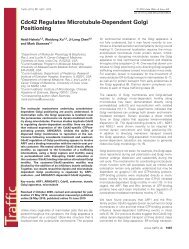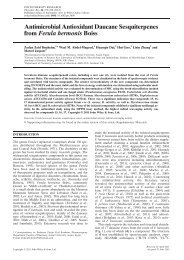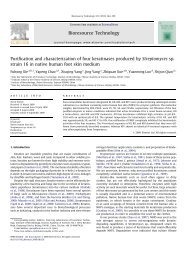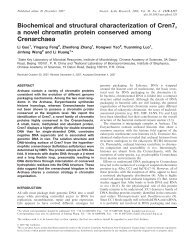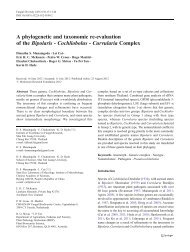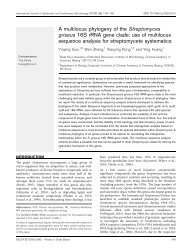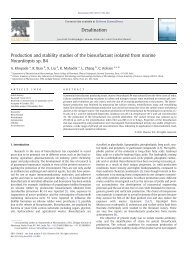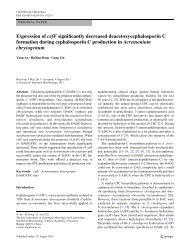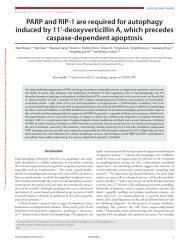Saturation mutagenesis of Acremonium chrysogenum deacetoxy ...
Saturation mutagenesis of Acremonium chrysogenum deacetoxy ...
Saturation mutagenesis of Acremonium chrysogenum deacetoxy ...
You also want an ePaper? Increase the reach of your titles
YUMPU automatically turns print PDFs into web optimized ePapers that Google loves.
Biotechnol Lett<br />
Many mutants <strong>of</strong> scDAOCS show increased ringexpanding<br />
activity towards penicillin G, most mutations<br />
were found in a small barrel subdomain (Wei<br />
et al. 2003; 2005) or in loops near this subdomain<br />
(Hsu et al. 2004), especially in the C-terminal<br />
residues 304–307 (Chin et al. 2004; Chin and Sim<br />
2002; Goo et al. 2008a, b; Lee et al. 2001; Wei et al.<br />
2003). Studies <strong>of</strong> <strong>Acremonium</strong> <strong>chrysogenum</strong> DAOC/<br />
DACS (acDAOC/DACS) (Lloyd et al. 1999; Wu<br />
et al. 2005) also revealed the importance <strong>of</strong> its<br />
C-terminal residues N305, M306 and R308 (the<br />
equivalents <strong>of</strong> residues 304, 305 and 307 in<br />
scDAOCS) in substrate selectivity and/or catalytic<br />
activity. In our previous research, mutation <strong>of</strong><br />
acDAOC/DACS R308 (R308L) was found to significantly<br />
improve its activity to convert penicillin G<br />
(Wu et al. 2005). This was the first time that R308<br />
was identified as a critical residue for acDAOC/<br />
DACS activity. To further confirm its role, we<br />
prepared a saturation <strong>mutagenesis</strong> library <strong>of</strong> R308<br />
<strong>of</strong> acDAOC/DACS, and evaluated the enzyme activities<br />
<strong>of</strong> the ensuing mutants.<br />
Methods<br />
Site-directed <strong>mutagenesis</strong><br />
QuikChange site-directed <strong>mutagenesis</strong> kit (Stratagene)<br />
was used according to manufacturer’s instructions<br />
with pET-CE (Wu et al. 2005) as <strong>mutagenesis</strong><br />
template. All mutant constructions were verified by<br />
DNA sequencing.<br />
Expression and purification <strong>of</strong> WT and mutant<br />
DAOC/DACS<br />
The mutant enzymes were expressed and purified<br />
using similar methods as described by Wu et al.<br />
(2005) with minor modifications: the E. coli cultures<br />
were grown at 25°C and induced with 0.4 mM<br />
isopropyl IPTG. The expressed DAOC/DACS were<br />
purified using an ÄKTA fast protein liquid chromatography<br />
system at 4°C. Cell-free extracts were<br />
loaded onto a Resource Q anion-exchange column<br />
(6 ml) pre-equilibrated with 30 ml buffer A (50 mM<br />
MOPS), 1 mM EDTA and 1 mM dithiothreitol<br />
(DTT), pH 8.0). The column was washed with<br />
12 ml buffer A and the expandase was eluted with<br />
a 0–200 mM NaCl linear gradient at 0.5 ml min -1 .<br />
The enzyme fractions were collected and concentrated<br />
to 0.5 ml before loading onto a Superdex 75<br />
10/300 GL column (10 9 300 mm) and eluted with<br />
36 ml buffer M (50 mM MOPS and 1 mM DTT, pH<br />
7.4) at 0.5 ml min -1 . The active fractions were<br />
collected and concentrated into a final volume <strong>of</strong><br />
0.5 ml.<br />
Enzyme assays and bioassay <strong>of</strong> penicillin<br />
conversion<br />
The ring-expansion activities <strong>of</strong> DAOC/DACS on<br />
various penicillin analogs were assayed using the<br />
same methods as described by Wu et al. (2005). The<br />
bioassay <strong>of</strong> penicillin conversion used a procedure<br />
similar to that <strong>of</strong> Cho et al. (1998).<br />
Spectrophotometric assay <strong>of</strong> penicillin conversion<br />
A spectrophotometric method similar to that reported<br />
previously by Baldwin and Crabbe (1987) was used.<br />
The reactions were performed at the same conditions<br />
as for bioassays. Relative specific activities for<br />
mutated enzymes were calculated as the ratio <strong>of</strong><br />
absorbance at 260 nm <strong>of</strong> mutant to that <strong>of</strong> WT<br />
enzyme.<br />
HPLC analyses<br />
A Phenomenex C18 column (3.9 9 300 mm) was<br />
used. Separation was performed with conditions<br />
similar to those <strong>of</strong> Chin and Sim (2002). Detection<br />
was simultaneously at 220 and 260 nm. The retention<br />
times <strong>of</strong> G-7-ADCA and penicillin G were 22.6 and<br />
23.5 min, respectively.<br />
Kinetic analyses<br />
Kinetic parameters <strong>of</strong> purified wild type (WT) and<br />
mutated enzymes for penicillin G conversion were<br />
determined using similar procedures as described for<br />
enzyme assay except the reaction time was 30 min.<br />
Penicillin G was used from 1 to 10 mM, while the<br />
amount <strong>of</strong> the enzyme was kept constant at<br />
0.7 mg ml -1 . The kinetic parameters were calculated<br />
via non-linear curve fit by Origin 6.1.<br />
123





